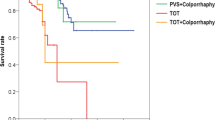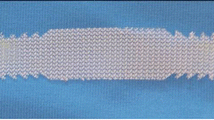Abstract
Objectives
To evaluate retrospectively the objective and subjective parameters in 42 male patients who underwent bone anchored sub-urethral sling positioning (BAUS) for SUI (stress urinary incontinence) due to ISD (intrinsic sphincter deficiency).
Methods
Patients with SUI due to radical retropubic prostatectomy (36 patients), transurethral resection of prostate (5 patients) and open simple prostatectomy (1 patient) underwent BAUS positioning between July 1999 and September 2005 (mean FU = 41 months). Before and after surgery, the patients were evaluated by physical examination, urethrocystoscopy, urodynamics, 1 h pad test and QoL questionnaire. Surgical technique involved perineal implantation to the pubic rami using four anchors of a sub-urethral sling made of synthetic (26 patients), biological (4 patients) or mixed (12 patients) material. Patients were stratified into three groups: (1) Cured: dry patients at stress test, pad weight 0–1 g. (2) Improved: patients with mild-moderate incontinence, pad weight 2–50 g. (3) Failed: unchanged patients, pad weight > 50 g.
Results
At the final follow-up visit cured, improved and failed patients were 26 (62%), 4 (8%) and 12 (30%), respectively. Mean pad weight significantly decreased from 104.6 to 47.3 g (55%) and mean total questionnaire score significantly increased to 50.7 (66%). Mean ALPP significantly increased to 50.4 cmH2O (44.8%). Better results were seen with synthetic slings. Main complications were perineal pain (76%), detrusor overactivity (12%) and sling infection (4.8%).
Conclusions
BAUS implantation is a safe, effective, minimally invasive option for iatrogenic male incontinence due to ISD. It compares favourably with AUS.
Similar content being viewed by others
References
Geary ES, Dendinger TE, Freiha FS, Stamey TA (1995) Incontinence and vesical neck strictures following radical retropubic prostatectomy. Urology 45:1000–1006
Kundu SD, Roehl KA, Eggener SE, Antenor JA, Han M, Catalona WJ (2004) Potency, continence and complications in 3477 consecutive radical retropubic prostatectomies. J Urol 172:2227–2231
Gomha MA, Boone TB (2003) Voiding patterns in patients with post prostatectomy incontinence: urodinamic and demographic analisys. J Urol 168:1766–1768
Poore RE, McCullough DL, Jarow JP (1998) Puboprostatic ligament sparing improves urinary continence after radical retropubic prostatectomy. Urology 51:67–72
Braslis KG, Petsch M, Lim A, Civantos F, Soloway MS (1995) Bladder neck preservation following radical prostatectomy: continence and margins. Eur Urol 28:202–208
Cambio AJ, Evans CP (2006) Minimising postoperative incontinence following radical prostatectomy: considerations and evidence. Eur Urol 50:903–913
Walsh PC, Marschke P, Ricker D, Burnett AL (2000) Patient-reported urinary continence and sexual function after anatomic radical prostatectomy. Urology 55:58–60
Litwin MS, Hays RD, Fink A, Ganz PA, Leake B, Leach GE, Brook RH (1995) Quality-of-life outcomes in men treated for localized prostate cancer. JAMA 273:129–131
Filocamo MT, Li Marzi V, Del Popolo G, Cecconi F, Marzocco M, Tosto A, Nicita G (2005) Effectiveness of early pelvic floor rehabilitation treatment for post-prostatectomy incontinence. Eur Urol 48:734–738
Hunter KF, Moore KN, Cody DJ, Glazener CM (2004) Conservative management for postprostatectomy urinary incontinence. Cochrane Database Syst Rev 2:1843–1845
Filocamo MT, Li Marzi V, Del Popolo G, Cecconi F, Villari D, Marzocco M, Nicita G (2006) Pharmacologic treatment in postprostatectomy stress urinary incontinence. Eur Urol 15:1850–1852
Schlenker B, Gratzke C, Reich O, Schorsch I, Seitz M, Stief CG (2006) Preliminary results on the off-label use of duloxetine for the treatment of stress incontinence after radical prostatectomy or cystectomy. Eur Urol 49:1075–1078
Clemens JQ, Schuster TG, Konnak JW, McGuire EG, Faerber GJ (2001) Revision rate after artificial urinary sphincter implantation for incontinence after radical prostatectomy: actuarial analisys. J Urol 166:1372–1374
Schneider T, Sperling H, Rossi R (2005) Do early injections of bulking agents following radical prostatectomy improve early continence? World J Urol 23:338–342
Madjar S, Raz S, Gousse AE (2001) Fixed and dynamic urethral compression for the treatment of post-prostatectomy urinary incontinence: is history repeating itself? J Urol 166:411–415
Ullrich NFE, Comiter CV (2004) The male sling for stress urinary incontinence: 24-months follow-up with questionnaire based assessment. J Urol 172:207–209
Madjar S, Jacoby K, Giberti C, Wald M, Halachmi S, Issaq E, Moskovitz B, Beyar M, Nativ O (2001) Bone anchored sling for the treatment of post-prostatectomy incontinence. J Urol 165:72–76
Abrams P, Cardozo L, Fall M (2002) The standardization of terminology of lower urinary tract function: report from the Standardization Sub-committee of the International Continence Society. Neurourol Urodyn 21:167–178
Wagner TH, Patrick DL, Bavendam TG (1996) Quality of life in persons with urinary incontinence: development of a new measure. Urology 47:67–72
Agresti A (ed) (1990) Categorical data analysis. Wiley, New York, pp 59–66
Grise P, Thurman S (2002) Urinary incontinence following treatment of localized prostate cancer. Cancer Control 8:532–539
Bosch JL, Klijn AJ, Schroder FH, Hop WC (2000) The artificial urinary sphincter in 86 patients with intrinsic sphincter deficiency: satisfactory actuarial adequate function rates. Eur Urol 38:156–160
Gousse AE, Madjar S, Lambert MM, Fishman IJ (2001) Artificial urinary sphincter for post radical prostatectomy urinary incontinence: long term subjective results. J Urol 166:1755–1757
Cespedes RD (2000) Collagen injection of artificial sphincter for postprostatectomy incontinence: collagen. Urology 55:5–6
Mizuo T, Tanizawa A, Yamada T, Ando M, Oshima H (1992) Sling operation for male stress incontinence by utilizing modified Stamey technique. Urology 39:211–214
Stern JA, Clemens JQ, Tiplitsky SI, Matschke HM, Jain PM, Schaeffer AJ (2005) Long term results of the bulbourethral sling procedure. J Urol 173:1654–1656
Comiter CV (2005) The male perineal sling: intermidiate-term results. Neurourol Urodyn 24:648–653
Clemens JQ, Bushman W, Schaeffer AJ (1999) Urodynamic analysis of the bulbourethral sling procedure. J Urol 162:1977–82
Dikranian AH, Chang JH, Rhee EY, Aboseif SR (2004) The male perineal sling: comparison of sling materials. J Urol 172:608–610
Hakim J, Gignac M (2004) Erosion of a male polypropylene sling. J Urol 172:1925–1926
Author information
Authors and Affiliations
Corresponding author
Rights and permissions
About this article
Cite this article
Giberti, C., Gallo, F., Schenone, M. et al. The bone-anchor sub-urethral sling for the treatment of iatrogenic male incontinence: subjective and objective assessment after 41 months of mean follow-up. World J Urol 26, 173–178 (2008). https://doi.org/10.1007/s00345-007-0222-3
Received:
Accepted:
Published:
Issue Date:
DOI: https://doi.org/10.1007/s00345-007-0222-3




